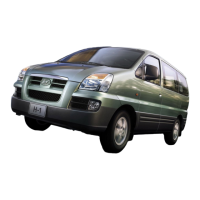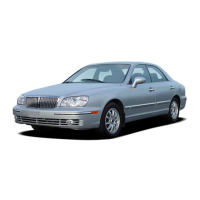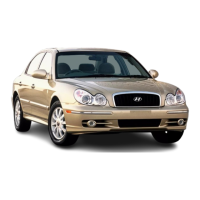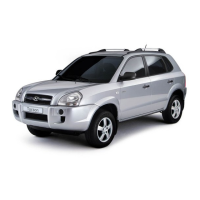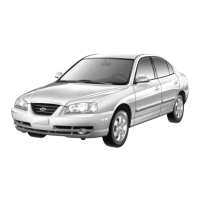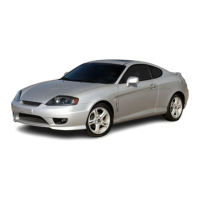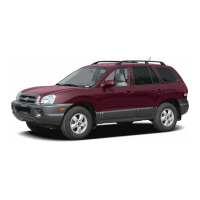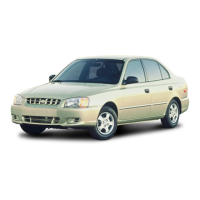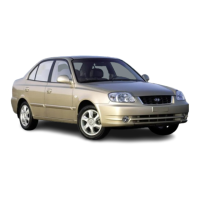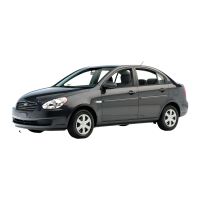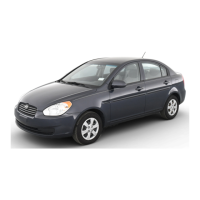Do you have a question about the Hyundai 2005 Accent and is the answer not in the manual?
Owner's responsibility to ensure scheduled maintenance is performed at appropriate intervals for optimal vehicle operation.
Information about Hyundai Motor Company and recommendations for owners.
Overview of the vehicle's instrument cluster with numbered indicators.
Explanation of various warning and indicator lights found on the instrument panel.
Explains the proper type of gasoline and fuel additives to use in your Hyundai.
Provides recommendations for the first 1200 miles (2000 km) for optimal operation and durability.
Details the convenience of Hyundai keys and the importance of a spare key.
Covers recording key numbers, locking/unlocking front doors, and child-protector rear door locks.
Explains how to replace transmitter battery and operate power windows, including auto-down feature.
Describes how to adjust front seats forward/rearward, seatback angle, lumbar support, and armrest.
Covers seat belt precautions, infant/child safety, larger children, pregnant women, and proper seat belt usage.
Explains proper placement and installation of child restraint systems, including tether anchor and ISOFIX.
Details the layout and function of the instrument cluster and various indicator lights.
Explains the meaning and operation of various warning and indicator lights on the instrument panel.
Describes how to use the trip computer for tripmeter, outside temperature, average fuel consumption, and distance to empty.
Explains the operation of turn signals, headlights, and lane change signals.
Details operation of windshield wipers (intermittent, low, high speed) and washers.
Covers manual and electric outside rearview mirrors, including heater and folding functions.
Explains how to unlatch and open the hood, and secure the support rod.
Describes operation of HVAC system, including center and side ventilators, fan speed, air intake, and air flow controls.
Explains how car audio systems work, AM/FM reception, and using cellular phones/two-way radios.
Details fixed rod and power antenna types and their operation.
Explains how to operate turn signals and what indicates a malfunction.
Describes how to use the lever for temporary turn signal indication.
Details how to operate the headlights and parking lights, including auto-off feature.
Instructions for operating the headlight high beams and low beams.
How to flash headlights, even when the main switch is off.
Explains how to use the windshield washer and notes on operation.
How to adjust manual outside rearview mirrors and safety cautions.
How to adjust electric outside rearview mirrors using the remote control.
How to open the trunk lid using the interior lever.
How to open the trunk lid using the key.
Location and adjustability of center dashboard vents for airflow direction.
Location and operation of side dashboard vents.
How to turn the blower fan on/off and select fan speed.
How to select fresh outside air or recirculating inside air.
Explains modes like Face-Level, Bi-Level, Floor-Level, Floor-Defrost, and Defrost-Level.
How to adjust the heating or cooling temperature.
How to use controls for simultaneous cool dashboard air and warm floor air.
How to turn the air conditioning system on and off using the A/C button.
Step-by-step guide to using the air conditioning for cooling the interior.
Steps to operate the air conditioning for dehumidified heating.
Explains how AM/FM radio signals are received and processed by the audio system.
How to remove and install the fixed rod antenna.
How the power antenna operates automatically with radio and ignition.
Checklist of actions to perform before starting the engine.
How to start the engine using the ignition switch and key positions.
Explanation of the ACC, ON, and START positions of the ignition switch.
How to operate the manual transmission, including shift points and reverse engagement.
Explanation of the automatic transmission shift lever positions (P, R, N, D, 2, L).
Advice on safe and effective braking techniques, including downhill driving and wet brakes.
How the ABS system works to prevent wheel lock-up during braking.
Tips for saving fuel and improving mileage, such as smooth driving and tire care.
Advice for driving in winter conditions, including snowy/icy roads and tire chain usage.
States that the Hyundai is not designed for trailer towing and potential warranty issues.
Information on vehicle capacity weight, seating capacity, and how to determine correct load limits.
Troubleshooting steps when the engine won't turn over or start.
Procedure for jump starting a vehicle with a discharged battery, including safety warnings.
Steps to take if the engine overheats, including checking coolant and drive belts.
Instructions for using the temporary spare tire, including pressure and limitations.
How to handle a flat tire situation, including safe stopping and hazard flashers.
Step-by-step guide to changing a flat tire, including wheel cap removal.
Advice on proper towing procedures to avoid vehicle damage and legal issues.
How to perform emergency towing if a commercial vehicle is unavailable.
Information on obtaining replacement keys or accessing the vehicle if keys are locked inside.
How Hyundai uses advanced practices and owner cooperation for long-term corrosion resistance.
Tips to prevent corrosion, emphasizing keeping the car clean and attending to high-corrosion areas.
Guidelines for washing and waxing the car, including spot cleaning and polishing.
Procedures for cleaning vinyl upholstery, carpets, seat belts, and windows.
Divides maintenance into scheduled procedures, general checks, and DIY tasks.
Outlines the importance of scheduled maintenance for warranty compliance and performance.
Lists items requiring more frequent servicing for cars used under severe driving conditions.
Provides details on specific maintenance items like engine oil, filters, belts, and fluids.
Identifies key components in the engine compartment for inspection and servicing.
Lists regular checks for the vehicle's interior, exterior, and engine compartment.
How to check and add engine oil, including recommended oil types and checking procedures.
Step-by-step guide for changing engine oil and filter, including safety and disposal notes.
How to check coolant level, recommended coolant, and procedure for changing coolant.
Guide to replacing spark plugs, including recommended types and safety precautions.
How to replace the air cleaner filter, including cautions about dust and proper installation.
How to check the manual transaxle oil level and capacity, including recommended fluid.
How to check automatic transaxle fluid level, capacity, and recommended fluid.
How to check brake fluid level, recommended fluid, and adding brake fluid.
How to check and replace clutch fluid, with warnings about handling brake fluid.
How to keep the air conditioner condenser clean and lubricate the compressor.
How to check the drive belt tension for the air conditioning compressor.
How to check steering wheel free-play and pedal free-play (clutch, brake).
How to check brake pedal clearance with a helper.
How to inspect drive belts for cracks, wear, and tension.
How to identify and replace blown fuses, including cautions on proper replacement.
How to check battery condition, clean terminals, and safety precautions when working with batteries.
Information on engine cooling fan and condenser cooling fan operation.
How to check the power steering fluid level, including notes on cold weather operation.
Steps for adjusting headlight aim, including specifications and alignment procedures.
How to replace headlight bulbs and other exterior/interior lights.
A table listing wattage for all exterior and interior light bulbs.
Location and description of fuses in the engine compartment and interior fuse panels.
Overview of the three main emission control systems: Crankcase, Evaporative, and Exhaust.
Explains the function of the catalytic converter and precautions for its operation.
Explains the VIN and its locations on the vehicle.
Location of the engine number on the engine block.
Information about tires, including tire information label and tire types (all season, snow, summer).
Recommended tire pressures and the importance of proper inflation.
Guidelines for installing and using tire chains, including safety warnings.
Recommended schedule for tire rotation and checking wheel nut torque.
Importance of tire balancing for handling and tire wear.
Factors affecting tire traction and the importance of proper inflation and tire condition.
How to identify when tires need replacement, including tread wear indicators and warnings.
Lists the spare tire and tools provided with the vehicle.
Information on how to obtain a factory Shop Manual for detailed servicing.
Overview of new vehicle limited and powertrain warranties.
Information regarding uniform tire quality grading (Treadwear, Traction, Temperature).
How to report vehicle safety defects to NHTSA and Hyundai Motor America.
Details the binding arbitration process for warranty claims and disputes.
Provides vehicle dimensions, tire size, inflation pressures, and electrical specifications.
Engine specifications including type, displacement, bore/stroke, idle speed, and spark plugs.
Table detailing recommended fluids, grease, and quantities for various vehicle components.
Identifies key components in the engine compartment for inspection and servicing.
Lists regular checks for the vehicle's interior, exterior, and engine compartment.
How to check and add engine oil, including recommended oil types and checking procedures.
Step-by-step guide for changing engine oil and filter, including safety and disposal notes.
How to check coolant level, recommended coolant, and procedure for changing coolant.
Guide to replacing spark plugs, including recommended types and safety precautions.
How to replace the air cleaner filter, including cautions about dust and proper installation.
How to check the manual transaxle oil level and capacity, including recommended fluid.
How to check automatic transaxle fluid level, capacity, and recommended fluid.
How to check brake fluid level, recommended fluid, and adding brake fluid.
How to check and replace clutch fluid, with warnings about handling brake fluid.
How to keep the air conditioner condenser clean and lubricate the compressor.
How to check the drive belt tension for the air conditioning compressor.
How to check steering wheel free-play and pedal free-play (clutch, brake).
How to check brake pedal clearance with a helper.
How to inspect drive belts for cracks, wear, and tension.
How to identify and replace blown fuses, including cautions on proper replacement.
How to check battery condition, clean terminals, and safety precautions when working with batteries.
Information on engine cooling fan and condenser cooling fan operation.
How to check the power steering fluid level, including notes on cold weather operation.
Steps for adjusting headlight aim, including specifications and alignment procedures.
How to replace headlight bulbs and other exterior/interior lights.
A table listing wattage for all exterior and interior light bulbs.
Location and description of fuses in the engine compartment and interior fuse panels.
Owner's responsibility to ensure scheduled maintenance is performed at appropriate intervals for optimal vehicle operation.
Information about Hyundai Motor Company and recommendations for owners.
Overview of the vehicle's instrument cluster with numbered indicators.
Explanation of various warning and indicator lights found on the instrument panel.
Explains the proper type of gasoline and fuel additives to use in your Hyundai.
Provides recommendations for the first 1200 miles (2000 km) for optimal operation and durability.
Details the convenience of Hyundai keys and the importance of a spare key.
Covers recording key numbers, locking/unlocking front doors, and child-protector rear door locks.
Explains how to replace transmitter battery and operate power windows, including auto-down feature.
Describes how to adjust front seats forward/rearward, seatback angle, lumbar support, and armrest.
Covers seat belt precautions, infant/child safety, larger children, pregnant women, and proper seat belt usage.
Explains proper placement and installation of child restraint systems, including tether anchor and ISOFIX.
Details the layout and function of the instrument cluster and various indicator lights.
Explains the meaning and operation of various warning and indicator lights on the instrument panel.
Describes how to use the trip computer for tripmeter, outside temperature, average fuel consumption, and distance to empty.
Explains the operation of turn signals, headlights, and lane change signals.
Details operation of windshield wipers (intermittent, low, high speed) and washers.
Covers manual and electric outside rearview mirrors, including heater and folding functions.
Explains how to unlatch and open the hood, and secure the support rod.
Describes operation of HVAC system, including center and side ventilators, fan speed, air intake, and air flow controls.
Explains how car audio systems work, AM/FM reception, and using cellular phones/two-way radios.
Details fixed rod and power antenna types and their operation.
Explains how to operate turn signals and what indicates a malfunction.
Describes how to use the lever for temporary turn signal indication.
Details how to operate the headlights and parking lights, including auto-off feature.
Instructions for operating the headlight high beams and low beams.
How to flash headlights, even when the main switch is off.
Explains how to use the windshield washer and notes on operation.
How to adjust manual outside rearview mirrors and safety cautions.
How to adjust electric outside rearview mirrors using the remote control.
How to open the trunk lid using the interior lever.
How to open the trunk lid using the key.
Location and adjustability of center dashboard vents for airflow direction.
Location and operation of side dashboard vents.
How to turn the blower fan on/off and select fan speed.
How to select fresh outside air or recirculating inside air.
Explains modes like Face-Level, Bi-Level, Floor-Level, Floor-Defrost, and Defrost-Level.
How to adjust the heating or cooling temperature.
How to use controls for simultaneous cool dashboard air and warm floor air.
How to turn the air conditioning system on and off using the A/C button.
Step-by-step guide to using the air conditioning for cooling the interior.
Steps to operate the air conditioning for dehumidified heating.
Explains how AM/FM radio signals are received and processed by the audio system.
How to remove and install the fixed rod antenna.
How the power antenna operates automatically with radio and ignition.
Checklist of actions to perform before starting the engine.
How to start the engine using the ignition switch and key positions.
Explanation of the ACC, ON, and START positions of the ignition switch.
How to operate the manual transmission, including shift points and reverse engagement.
Explanation of the automatic transmission shift lever positions (P, R, N, D, 2, L).
Advice on safe and effective braking techniques, including downhill driving and wet brakes.
How the ABS system works to prevent wheel lock-up during braking.
Tips for saving fuel and improving mileage, such as smooth driving and tire care.
Advice for driving in winter conditions, including snowy/icy roads and tire chain usage.
States that the Hyundai is not designed for trailer towing and potential warranty issues.
Information on vehicle capacity weight, seating capacity, and how to determine correct load limits.
Troubleshooting steps when the engine won't turn over or start.
Procedure for jump starting a vehicle with a discharged battery, including safety warnings.
Steps to take if the engine overheats, including checking coolant and drive belts.
Instructions for using the temporary spare tire, including pressure and limitations.
How to handle a flat tire situation, including safe stopping and hazard flashers.
Step-by-step guide to changing a flat tire, including wheel cap removal.
Advice on proper towing procedures to avoid vehicle damage and legal issues.
How to perform emergency towing if a commercial vehicle is unavailable.
Information on obtaining replacement keys or accessing the vehicle if keys are locked inside.
How Hyundai uses advanced practices and owner cooperation for long-term corrosion resistance.
Tips to prevent corrosion, emphasizing keeping the car clean and attending to high-corrosion areas.
Guidelines for washing and waxing the car, including spot cleaning and polishing.
Procedures for cleaning vinyl upholstery, carpets, seat belts, and windows.
Divides maintenance into scheduled procedures, general checks, and DIY tasks.
Outlines the importance of scheduled maintenance for warranty compliance and performance.
Lists items requiring more frequent servicing for cars used under severe driving conditions.
Provides details on specific maintenance items like engine oil, filters, belts, and fluids.
Identifies key components in the engine compartment for inspection and servicing.
Lists regular checks for the vehicle's interior, exterior, and engine compartment.
How to check and add engine oil, including recommended oil types and checking procedures.
Step-by-step guide for changing engine oil and filter, including safety and disposal notes.
How to check coolant level, recommended coolant, and procedure for changing coolant.
Guide to replacing spark plugs, including recommended types and safety precautions.
How to replace the air cleaner filter, including cautions about dust and proper installation.
How to check the manual transaxle oil level and capacity, including recommended fluid.
How to check automatic transaxle fluid level, capacity, and recommended fluid.
How to check brake fluid level, recommended fluid, and adding brake fluid.
How to check and replace clutch fluid, with warnings about handling brake fluid.
How to keep the air conditioner condenser clean and lubricate the compressor.
How to check the drive belt tension for the air conditioning compressor.
How to check steering wheel free-play and pedal free-play (clutch, brake).
How to check brake pedal clearance with a helper.
How to inspect drive belts for cracks, wear, and tension.
How to identify and replace blown fuses, including cautions on proper replacement.
How to check battery condition, clean terminals, and safety precautions when working with batteries.
Information on engine cooling fan and condenser cooling fan operation.
How to check the power steering fluid level, including notes on cold weather operation.
Steps for adjusting headlight aim, including specifications and alignment procedures.
How to replace headlight bulbs and other exterior/interior lights.
A table listing wattage for all exterior and interior light bulbs.
Location and description of fuses in the engine compartment and interior fuse panels.
Overview of the three main emission control systems: Crankcase, Evaporative, and Exhaust.
Explains the function of the catalytic converter and precautions for its operation.
Explains the VIN and its locations on the vehicle.
Location of the engine number on the engine block.
Information about tires, including tire information label and tire types (all season, snow, summer).
Recommended tire pressures and the importance of proper inflation.
Guidelines for installing and using tire chains, including safety warnings.
Recommended schedule for tire rotation and checking wheel nut torque.
Importance of tire balancing for handling and tire wear.
Factors affecting tire traction and the importance of proper inflation and tire condition.
How to identify when tires need replacement, including tread wear indicators and warnings.
Lists the spare tire and tools provided with the vehicle.
Information on how to obtain a factory Shop Manual for detailed servicing.
Overview of new vehicle limited and powertrain warranties.
Information regarding uniform tire quality grading (Treadwear, Traction, Temperature).
How to report vehicle safety defects to NHTSA and Hyundai Motor America.
Details the binding arbitration process for warranty claims and disputes.
Provides vehicle dimensions, tire size, inflation pressures, and electrical specifications.
Engine specifications including type, displacement, bore/stroke, idle speed, and spark plugs.
Table detailing recommended fluids, grease, and quantities for various vehicle components.
Identifies key components in the engine compartment for inspection and servicing.
Lists regular checks for the vehicle's interior, exterior, and engine compartment.
How to check and add engine oil, including recommended oil types and checking procedures.
Step-by-step guide for changing engine oil and filter, including safety and disposal notes.
How to check coolant level, recommended coolant, and procedure for changing coolant.
Guide to replacing spark plugs, including recommended types and safety precautions.
How to replace the air cleaner filter, including cautions about dust and proper installation.
How to check the manual transaxle oil level and capacity, including recommended fluid.
How to check automatic transaxle fluid level, capacity, and recommended fluid.
How to check brake fluid level, recommended fluid, and adding brake fluid.
How to check and replace clutch fluid, with warnings about handling brake fluid.
How to keep the air conditioner condenser clean and lubricate the compressor.
How to check the drive belt tension for the air conditioning compressor.
How to check steering wheel free-play and pedal free-play (clutch, brake).
How to check brake pedal clearance with a helper.
How to inspect drive belts for cracks, wear, and tension.
How to identify and replace blown fuses, including cautions on proper replacement.
How to check battery condition, clean terminals, and safety precautions when working with batteries.
Information on engine cooling fan and condenser cooling fan operation.
How to check the power steering fluid level, including notes on cold weather operation.
Steps for adjusting headlight aim, including specifications and alignment procedures.
How to replace headlight bulbs and other exterior/interior lights.
A table listing wattage for all exterior and interior light bulbs.
Location and description of fuses in the engine compartment and interior fuse panels.
| Brand | Hyundai |
|---|---|
| Model | 2005 Accent |
| Category | Automobile |
| Language | English |
